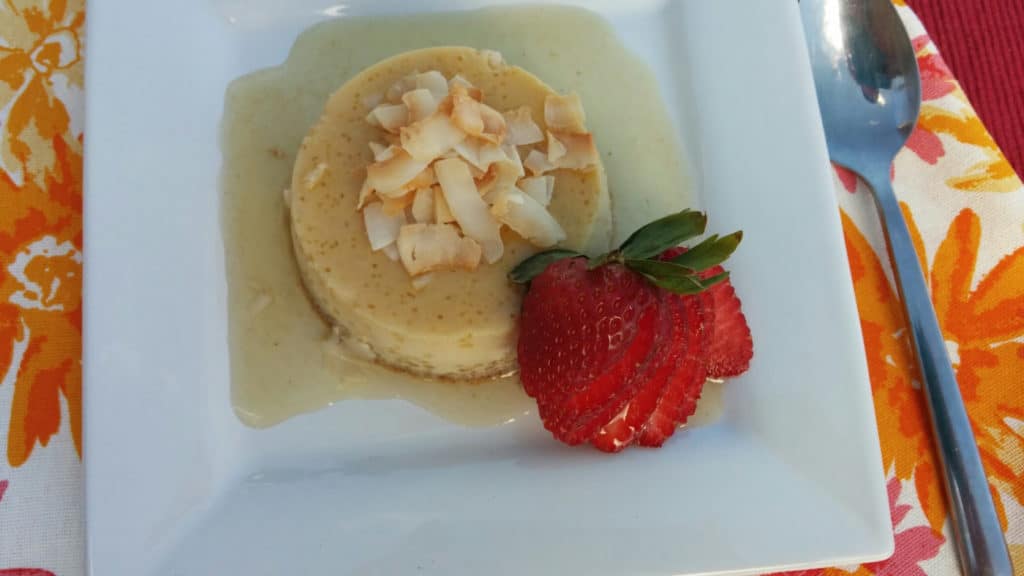Flan is a classic egg custard dessert, particularly familiar to many Latin American tables. Though regional variations are found all over the world, flan’s roots are most likely found in France, where the custard is more commonly known as crème caramel. The dessert is essentially a reversed crème brûlée, with an exception that flan and crème caramel are generally made with milk and crème brûlée with heavy cream.
If you’re a fan of honey, then this is the dessert for you. The utter simplicity of flan provides an ideal atmosphere to let the true essence of honey shine through without much competition. I’ve swapped out the usual milk for coconut milk to add a unique backdrop and play off the Latin American theme, but you may also use milk (preferably raw) for a truer honey flavor. For this version, I chose a fairly neutral-flavored light amber wildflower honey with a mild aroma so that the subtle coconut flavor would be apparent. However, I think this dessert would be an excellent way to showcase more assertive types, like buckwheat honey, or unique varieties like rosemary or chestnut honey. Try to obtain raw, and preferably local, honey whenever possible, for its purity and beneficial pollen.
Traditionally, flan is made by cooking sugar until it caramelizes, which will eventually be the sauce for the custard. Making caramel can be a little tricky for the novice chef, as it has the tendency to crystallize easily and can go from pale gold to burnt in mere seconds. For this reason, I think many people may shy away from what is an otherwise foolproof dessert. By replacing the caramel with honey, we eliminate virtually all the risk and can have a super simple, honey-sweet treat on the table in no time.
Ingredients
Serves 4
3 eggs, beaten
1 1/2 cups coconut milk, or whole milk (preferably raw)
6 tablespoons honey, divided (preferably raw, local honey)
1 teaspoon vanilla
1/8 teaspoon cinnamon
Pinch salt
Optional garnishes: whipped cream, shredded coconut, fresh fruit
Method
1. Preheat the oven to 325 F.
2. Beat eggs in a medium-sized bowl. Combine milk and 3 tablespoons honey in a small pot. Gently warm, stirring, until honey is melted. Pour into bowl with eggs,then add vanilla and cinnamon and whisk until fully combined.
3. Divide remaining honey up evenly between four individual ramekins or small, oven-safe dessert dishes. Tilt dishes so that the honey completely coats the base of each dish. Place ramekins into a larger casserole dish. Divide egg custard evenly among ramekins.
4. Pour hot water into the large baking dish so that the water reaches about halfway up the side of the ramekins. Carefully transfer casserole dish to the oven.
5. Bake custards until barely set, about 40–50 minutes. They should still jiggle slightly, but a knife inserted into the center should come out clean.
6. Using tongs, carefully transfer ramekins from casserole dish to a cooling rack. Cool to warm, then transfer to fridge for at least 2 or 3 hours, until completely chilled. To serve, run a knife around the edge of each custard. Invert a serving plate on top of custard and flip over, giving custard a bit of a jolt to release cleanly from ramekin.
7. Serve with whipped cream, shredded coconut, or fresh fruit, if desired.
AUTHOR’S NOTE
To choose your organically grown and fresh ingredients wisely, use the following criteria:
·chemical- and hormone-free meat
·wild-caught fish
·pastured-raised, organic eggs
·whole, unrefined grains
·virgin, unrefined, first-press organic oils
·whole-food, unrefined sweeteners
·pure, clean, spring water
·sea salt
·raw and/or cultured milk and cream products


